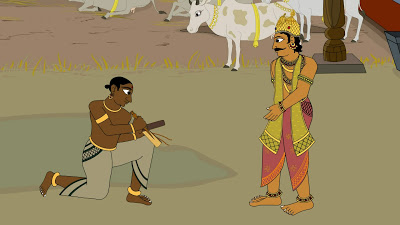SHOULD SACRED COWS BE ALLOWED TO RUIN THIS FINE SUGARCANE FIELD?
Now, immediately on the heels of the drought described in my previous blog(post 1.24), a second disaster unfolds in Ponnivala. The problem begins as the Chola’s ear-tagged cows reach Kolatta’s lands and find his finest field. It stands out for its tasty, near-mature crop of sugarcane. The cows eye the delicious-looking stand of tall stalks
- Published in Blog
WHY IS THIS SCRIBE WRITING NOTES IN THE KING’S COW SHED?
This clip presents a rather unique set of scenes. There has been a sudden and severe famine in the Chola’s kingdom. Interestingly enough, this repeats a very similar disaster event that earlier befell the Vellivala area, the place where Kolatta and his eight brothers first tried to farm (see blog post 1.7?). Everything is dry,
- Published in Blog
WHY HAVE ALL THESE TREES BEEN FELLED?
This short and simple video excerpt is included here as a set of add-on comments that build on my last blog (1.22) where one of the regularly repeated songs in the The Legend of Ponnivala epic is featured. That song speaks about the beauty of Ponnivala, its ripening fields of paddy and its lush, green
- Published in Blog
DOES THE LAND BENEFIT FROM THIS FARMER’S PRAYERS?
This clip begins with Kolatta remembering the Chola king’s words. He will indeed worship the local goddess of who cares for Ponnivala’s lands, Celatta, three times each day. We see the couple involved in this together. The two greet the goddess respectfully. Then Kolatta’s wife sweeps and clears the area in front of the temple.
- Published in Blog
WHY HAS THIS GODDESS SHRINE BEEN NEGLECTED?
The goddesses who guard the key local areas in this Legend of Ponnivala story are very important. We will encounter three key divine females in this epic, each having their own distinct shrine. These goddesses are Celatta, Kali (who is a kind of Durga-figure) and Karukali (or the black and very fearsome Kali). I will
- Published in Blog
WHEN DOES A SIMPLE BOUNDARY STONE SPELL TROUBLE?
We now enter a new era, so to speak, in The Legend of Ponnivala story. The immigrant farmers have already arrived and are ready to settle in. And, after the happy outcome of Vishnu’s impressive ceremony, they are able to claim a legitimate god-given right to bring the lands of this remote region under the
- Published in Blog
IS THE OUTCOME OF LORD VISHNU’S COVENENT FAIR TO ALL?
I have essentially already answered this question in the negative, in several previous blogs. However, the actual contract Vishnu imposes on these farmer–artisan rivals is worth reviewing in detail. It is that contract which I will discuss in more depth here. Vishnu starts the clip by publically declaring that the lands of Ponnivala will now
- Published in Blog
WHAT ALLOWS THIS FARMER TO ESCAPE HARM?
This next clip begins with a view of the neat layout of eighteen ritual offerings on a large cloth. Soon several artisan arms (that we know belong to the artisan’s side in this contest) are then seen picking up the four swords lying there. But now the scene is interrupted by a brief conversation. In
- Published in Blog
SHOULD THE ARTISANS AGREE TO VISHNU’S RITUAL TEST?
This clip actually precedes the previous one. I have chosen to discuss these two excerpts in reverse chronological in order to clarify the “set-up” these artisans are faced with, first. It is now appropriate to ask why do they agree to this contest? After all, they walked out of the Chola palace in protest. Why
- Published in Blog
storytelling and social justice
Just yesterday, a conference entitled “Making Anthropology Matter” concluded in Prague (October 14th and 15th, 2015). The topic under scrutiny articulated European professional anthropologists’ ongoing concerns about how to best apply their largely-academic research efforts. Many anthropologists hope to usefully relate their findings to contemporary social concerns. With this in mind, most conference participants spoke about the tension they
- Published in News








